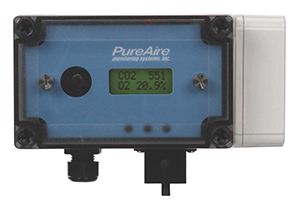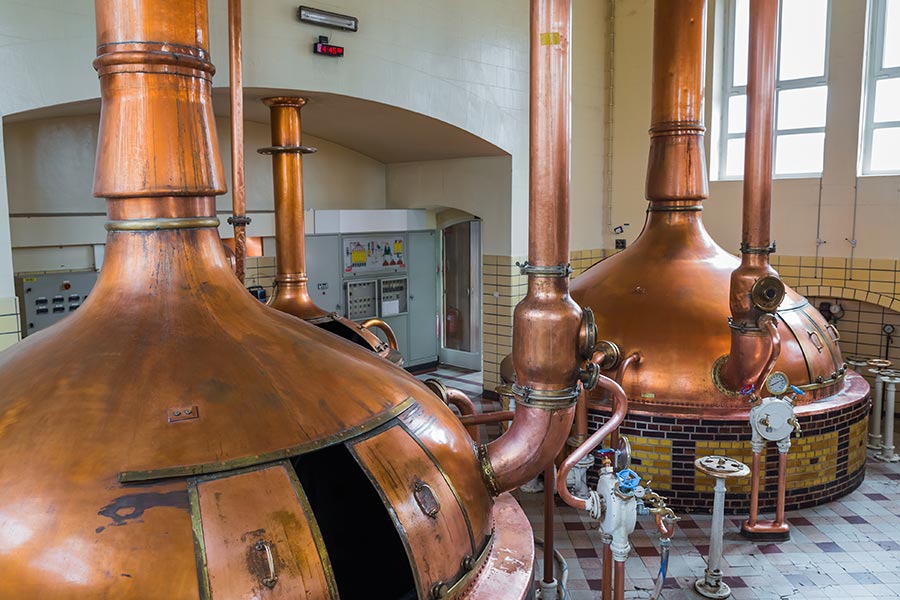Brewers Safely Capture and Reuse Carbon Dioxide
- By : PureAire Monitoring Systems
- Posted on : November 11, 2020
- News Room
Brewing beer produces carbon dioxide (CO2), especially during fermentation (the process by which yeast converts sugars into alcohol). Estimates are that fermentation yields three times as much carbon dioxide as is actually needed to produce (including brewing, canning, and bottling) each batch of beer, with up to 15 grams of CO2 generated per pint of beer brewed. According to the British Beer & Pub Association, over 8 billion pints of beer were consumed in the United Kingdom alone in 2019, contributing to the production of a whole lot of carbon dioxide.
While large, global breweries, with their vast financial resources, have been recapturing and reusing carbon dioxide for a number of years, most craft brewers have considered carbon recapture technology to be prohibitively expensive. They have treated excess CO2 as waste, and vented it into the atmosphere, though that practice may make little sense, either economically or environmentally since, in order to produce subsequent batches, brewers must then turn around and purchase carbon dioxide to carbonate the beer, purge beer tanks and lines of oxygen, and to transfer the beer from tanks to bottles or cans.
And carbon dioxide purchase is a recurring line-item expense that eats into craft brewers’ profit margins.
Capturing and Reusing Carbon Dioxide
The good news is that recent technological innovations, driven in large part by companies working with NASA on space exploration and investigation, have led entrepreneurs to an awareness that CO2 recapture may in fact now be seen as a relatively affordable, and certainly environmentally friendly, option for craft breweries. The technology involves capturing the CO2 that has accumulated during fermentation and purifying the gas to make it suitable for reuse and/or sale.
The Washington Post has reported that Texas-based Earthly Labs has created a product called “CiCi” (for “carbon capture”), a refrigerator-sized unit that enables brewers to trap and reuse accumulated carbon dioxide. Captured CO2 is piped from the fermentation tanks to a “dryer” to separate water from CO2gas. The gas is next purified and chilled to a liquid for ease of storage and subsequent use.
Brewers can reuse their stored carbon dioxide to carbonate new batches of beer, as well as in the canning and bottling processes for the new beer. Craft Brewing Business, a trade website dedicated to the business of commercial craft brewing, reports that breweries can reduce monthly carbon dioxide expenses by 50 percent or more, and CO2 emissions by up to 50%, via carbon capture technology.
Breweries that capture more CO2 than they can use, may elect to sell the surplus to other breweries, bars, restaurants, and any other businesses that also use carbon dioxide. For instance, the State of Colorado, Earthly Labs, the Denver Beer Co., and The Clinic announced in early 2020 a pilot program in which Denver Beer Co. would sell its surplus CO2 to The Clinic, a medical and recreational cannabis dispensary, which would then pump the carbon dioxide inside its grow rooms to stimulate and enrich plant growth.
Oxygen Monitors Can Mitigate Unseen Dangers of Carbon Dioxide
Brewers and others working around carbon dioxide need to be aware of the potential risks associated with CO2. Carbon dioxide is an odorless and colorless oxygen-depleting gas. Since it deprives the air of oxygen, CO2 use presents a potential health hazard for brewery personnel.
According to the Occupational Safety and Health Administration (OSHA), an environment in which oxygen levels fall below 19.5 percent is considered an oxygen-deficient atmosphere and should be treated as immediately dangerous to health or life. When there is not enough oxygen in the air, persons working in the affected area may become disoriented, lose consciousness, or even suffocate due to the lack of sufficient oxygen. Because CO2 is devoid of odor and color, individuals working around it might well, in the absence of appropriate monitoring equipment, be unaware that a risk situation has developed.
As such, The National Fire Protection Association recommends that gas monitoring equipment be placed in storage areas or any place where carbon dioxide is used or stored.
PureAire Dual O2/CO2 Monitors
 PureAire Monitoring Systems’ Dual Oxygen/Carbon Dioxide Monitor offers thorough air monitoring, with no time-consuming maintenance or calibration required. A screen displays current oxygen and carbon dioxide levels for at-a-glance reading by brewery employees, who derive peace of mind from the Monitor’s presence and reliable performance.
PureAire Monitoring Systems’ Dual Oxygen/Carbon Dioxide Monitor offers thorough air monitoring, with no time-consuming maintenance or calibration required. A screen displays current oxygen and carbon dioxide levels for at-a-glance reading by brewery employees, who derive peace of mind from the Monitor’s presence and reliable performance.
In the event of a carbon dioxide leak, and a decrease in oxygen to an unsafe level, PureAire’s Monitor will set off an alarm, complete with horns and flashing lights, alerting brewery personnel to evacuate the area.
PureAire’s Dual Oxygen/Carbon Dioxide Monitor is well-suited for facilities where carbon dioxide is used, such as breweries, bars, and restaurants. Our Dual O2/CO2 monitor includes both a non-depleting, zirconium oxide sensor cell, to monitor oxygen levels, and a non-dispersive infrared (NDIR) sensor cell, to monitor carbon dioxide levels. PureAire’s O2/CO2 monitors can last, trouble-free, for over 10 years under normal operating conditions.
Saving money, reducing greenhouse gas emissions, and ensuring employee safety…that is certainly something to which we can all raise a glass.



